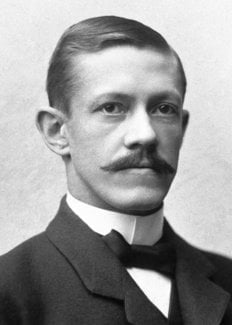Allvar Gullstrand
Biographical

Allvar Gullstrand, eldest son of Dr. Pehr Alfred Gullstrand, Principal Municipal Medical Officer, and his wife Sofia Mathilda née Korsell, was born on June 5, 1862, at Landskrona. He was educated at schools in Landskrona and Jönköping, where he passed his matriculation in 1880; he then went to Uppsala University, which he left in 1885, and spent a year at Vienna, afterwards continuing his medical studies at Stockholm where he graduated in medicine in 1888, presented his doctorate thesis in 1890, and was appointed Lecturer in Ophthalmology in 1891. After holding various appointments as Doctor and Lecturer and serving on the Swedish Medical Board, he was appointed the first Professor of Ophthalmology at Uppsala University in 1894.
He occupied this post until 1913. As from 1914 onwards he held a Personal Professorship in Physical and Physiological Optics at Uppsala University. He was appointed Emeritus Professor in 1927.
He was entirely self-taught in the fields covering his most important work (geometric and physiological optics). The basis of the science he developed was laid in 1890 in his thesis Bidrag till astigmatismens teori (Contribution to the theory of astigmatism). The complete proof of this theory is found in the following three works: Allgemeine Theorie der monochromatischen Aberrationen und ihre nächsten Ergebnisse für die Ophthalmologie (General theory of monochromatic aberrations and their immediate significance for ophthalmology), 1900, which received awards from the Swedish Royal Academy of Sciences and the Swedish Medical Association; Die reelle optische Abbildung (The true optical image), 1906; and Die optische Abbildung in heterogenen Medien und die Dioptrik der Kristallinse des Menschen (The optical image in heterogeneous media and the dioptrics of the human crystalline lens), 1908, which was awarded the Centenary Gold Medal of the Swedish Medical Association. The results are combined in the works Tatsachen und Fiktionen in der Lehre von der optischen Abbildung (Facts and fictions in the theory of the optical image), 1907; Handbuch der physiologischen Optik (Handbook of physiological optics), by H. von Helmholtz, 3rd edition, Vol. I, 1909, and Einführung in die Methoden der Dioptrik der Augen des Menschen (Introduction to the methods of the dioptrics of the human eyes), 1911.
Of his other works, the following received awards: Objektive Differential-diagnostik und photographische Abbildung von Augenmuskellähmungen (The objective differential diagnosis and photographic illustration of disabilities of the eye muscles), 1892; Photographisch-ophthalmometrische und klinische Untersuchungen über die Hornhautrefraktion (Photographic-ophthalmometric and clinical investigations of corneal refractions), 1896; Die Farbe der Macula centralis retinae (The pigments of the central macula of the retina), 1905; the first two received awards from the Swedish Medical Association and the latter received the Björkén Prize of the Uppsala Faculty of Medicine.
As the holder of the Research Professorship in Physical and Physiological Optics, Gullstrand devoted himself mainly to calculations and methods for achieving a more suitable form of refracting surfaces in optical instruments, and to investigation of optical system laws of higher order. A result of the former is a record which is kept in the Uppsala University library and which relates to calculations for optical systems, inter alia optical systems with appropriate non-spherical surfaces, and the publication Über asphärische Flächen in optischen Instrumenten (On aspheric surfaces in optical instruments), 1919. As a result of the latter we may mention the publications Das allgemeine optische Abbildungssystem (The general optical image system), 1915 and Optische Systemgesetze zweiter und dritter Ordnung (Laws of the optical system of the second and third order), 1924. He gave the last summary of his optical experiments in Einiges über optische Bilder (Some aspects of optical images), 1926.
His methods of focal illumination, particularly by means of the slit lamp (1911), have acquired the greatest importance to the practical ophthalmologist. His reflex-free ophthalmoscope (1911) is also a valuable instrument to the ophthalmological diagnostician.
His great administrative ability found expression particularly in the Faculty of Medicine and the Council of Uppsala University and the Swedish Academy of Sciences.
Gullstrand was an honorary Doctor of Philosophy of the Universities of Uppsala, Jena and Dublin, and a member of a number of Swedish and foreign scientific societies. In 1911 he received the Nobel Prize for his work on the dioptrics of the eye. He was member of the Nobel Physics Committee of the Swedish Academy of Sciences (1911-1929), and its Chairman (1922-1929). In 1927 he was awarded the Graefe Medal of the Deutsche Ophthalmologische Gesellschaft.
In 1885 he married Signe Christina Breitholtz. They had one daughter, who died at an early age. Gullstrand died in Stockholm on July 28, 1930.
This autobiography/biography was written at the time of the award and first published in the book series Les Prix Nobel. It was later edited and republished in Nobel Lectures. To cite this document, always state the source as shown above.
The Nobel Foundation's copyright has expired.Nobel Prizes and laureates
Six prizes were awarded for achievements that have conferred the greatest benefit to humankind. The 14 laureates' work and discoveries range from quantum tunnelling to promoting democratic rights.
See them all presented here.
